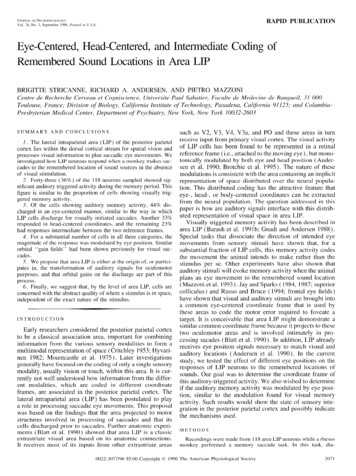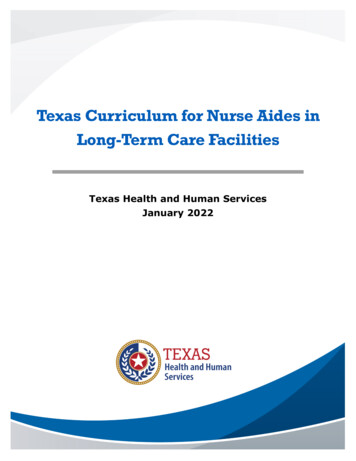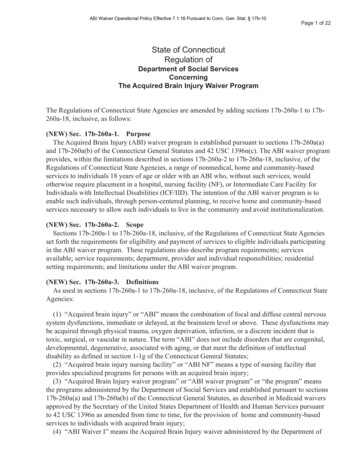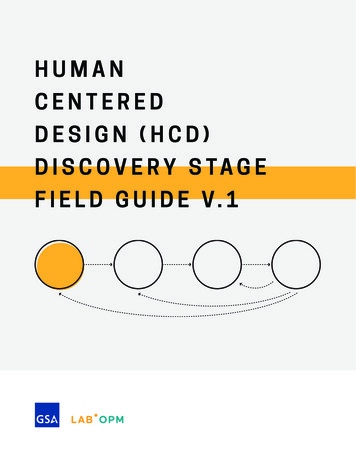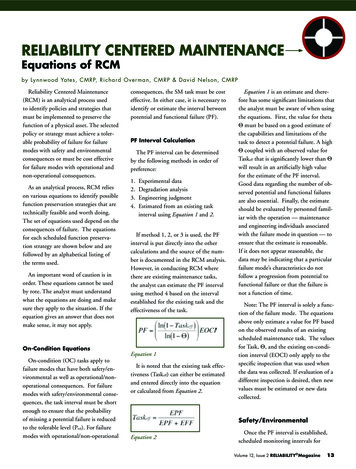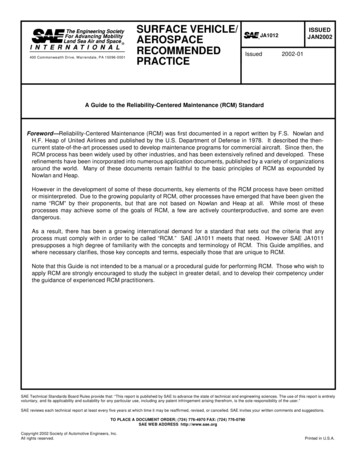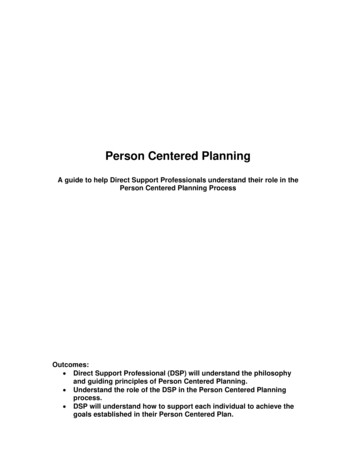
Transcription
Person Centered PlanningA guide to help Direct Support Professionals understand their role in thePerson Centered Planning ProcessOutcomes: Direct Support Professional (DSP) will understand the philosophyand guiding principles of Person Centered Planning. Understand the role of the DSP in the Person Centered Planningprocess. DSP will understand how to support each individual to achieve thegoals established in their Person Centered Plan.
PCP TRAINING CHECKLISTTrainer will assure that the following is completed for Person Centered PlanningTraining:1. Direct Support Professionals will read the Person Centered Planning Unit.2. Direct Support Professionals will complete the PCP test and turn in to theQualified Trainer. – Trainer will review with the DSP using the answer key.3. Direct Support Professionals will read each person’s Individual Plan ofService.4. Direct Support Professionals will specifically review the Goals and Objectivesin the Plans for each person and know how and when to implement them.5. Direct Support Professionals will meet with each person that lives in the homeand ask them about their PCP. If the person is non-verbal they should take timeto observe the person so they have a clear vision on the person’s plan and how itshould be implemented for that person.6. Direct Support Professionals will be shown where and how to documentprogress towards a person’s individual goals.7. Trainer will review the Handouts: “Person Centered Information” “PreplanningChecklist” and “Person/Family Centered Plan” located at the end of this unit withthe DSP.8. Trainer will answer any questions the D.S.P. may have related to PCP9. Trainer will give the D.S. P. the “Choices” activity and review the answers withthem.10. Trainer will give the DSP the choices activity: “Stop, Go, Caution”. Trainerwill then review the answers with the DSP and provide examples of the choicesthe individuals who live there have made. Remember to include the Individualswho live in the home in this activity!Optional Activities for Larger Groups: Bringing Person Centered Planning Home Person Centered Planning Party Activity
THE PERSON CENTERED PLANNING PROCESSHISTORY OF TRADITIONAL SERVICESInstitutional Reform Period:During the 1960’s and the 1970’s, individuals with disabilities were generally cared for inlarge congregate settings (i.e. institutions) under the medical model of service delivery.Many of the people you provide services to may have lived in an institution. In the1960’s and 1970’s people with disabilities/mental illness were treated like “patients” andreceived services under the supervision of a doctor and other medical staff. Themedical professionals and other staff controlled the planning process and the focus ofthe care was to control or maintain the “condition” of the patients.In 1963 president Kennedy felt that the way we cared for the DevelopmentallyDisabled/Mentally Ill population was wrong. He was the 1st president to addresscongress on behalf of the Developmentally Disabled/Mentally Ill population. After thatthings really began to change! This was the beginning of Institutional Reform. Heproceeded to change the financial structure, which resulted in many changes in thedelivery of care.Deinstitutionalization Period:During the late 1960’s through the mid 1980’s, many individuals were released from theinstitutions into community settings. This was called the “deinstitutionalization period.”Most individuals were placed in group homes, sheltered workshops, day activityprograms, and special schools or classrooms. In these community-based programs,individuals with disabilities were generally treated under the developmental orbehavioral model of service delivery which was based on active treatment standards.Supports were referred to as programs and an inter-disciplinary team (I-Team) ofmental health professionals, medical professionals, and staff controlled the planningprocess. The major focus of intervention or care was to change behavior. Thisincluded decreasing or eliminating behaviors seen as undesirable and/or enhancingskills that would be developmentally appropriate for someone without disabilities, forexample name writing, time identification, shoe tying, coin counting, activities of dailyliving (ADL) skills.Although care for individuals using the developmental model of service delivery wasmore humane than the medical model there were still concerns. When the deliverysystem focuses on the person’s deficits, the following problems can develop: PCPThe focus is on deficits or problem areas.Such a focus creates a negative picture of a person.We risk not obtaining a complete picture of who the person is.The focus then turns to limiting aspects of a person’s life.11/7/2011
You begin defining service options based on how to “fix the problem.”You may fail to identify available supports and resources.You may work with data from those who don’t “truly know” the person.This leads to making inaccurate judgments about the person.Opportunities to learn about the person’s dreams, needs, skills, gifts, capacities,preferences are then missed.The developmental model based on active treatment continued until revisions weremade to the Mental Health Code – Sec. 712 in 1996.Community Membership Period:The 1996 revisions to the Mental Health Code require a “person centered” approach tothe planning, selection, and delivery of the supports, services, and/or treatment youreceive from the public mental health system (community mental health programs,centers for persons with developmental disabilities, psychiatric hospitals, and mentalhealth service providers under contract to any of these). Person Centered Planning is aprocess of learning how a person wants to live. Within this process, the person buildsupon his or her capacity to engage in activities that promote community life. It honorsthe person’s preferences, choices, and abilities, while involving family, friends andprofessionals as the person desires or requires.Currently, and in effect since 2000, everything begins with Person Centered Planning.Self Determination is a natural progression of Person Centered Planning. SelfDetermination assures people with developmental disabilities and or mental illness theauthority to make meaningful choices, and control their own lives.Without good Person Centered Planning, self determination is not possible. It involvesproviding choices and new experiences. Through choice, people make decisions andgood decision making can be taught. This process leads to persons wanting morecontrol over their lives. Many persons with disabilities want the responsibility for andcontrol of: their money, hiring and firing their own staff, where they live, and who theylive with.Person/Family Centered PlanMichigan law requires that all individuals who receive services from a mental healthagency will have an individual plan of service developed through a Person CenteredPlanning process, regardless of age, disability, or residential setting.Person Centered Planning is a process of planning for and supporting the individualreceiving services. This planning model builds upon the individual’s strengths andcapacity to engage in community activities, while honoring the individual’s preferences,choices, and abilities. This process involves those family members, friends, andprofessionals the individual wishes or requires. The process encourages formal andinformal feedback from the individual about his/her supports and services, the progressPCPPage 221/7/2011
informal feedback from the individual about his/her supports and services, the progressmade, and any changes desired or required. The exclusion of a person chosen by theindividual to participate in this process must be documented.Self Determination enables all eligible individuals to assume responsibility for planningand spending for the supports necessary to live and participate in the community. Itprovides freedom and authority to make choices regarding services and supports bothformal and informal.Guiding Principles:The basic beliefs of Person Centered Planning are as follows:1. The person’s desired future will become the framework for all planning.2. The most important part of this process is the dreams, desires, and preferencesof the individual.3. Planning will begin with input from the individual. Planning will also be decidedby and include additional information from the people most important to theindividual, and as appropriate, information from professionals.4. A net planning process will be used, i.e., the plan of service begins with what theindividual can do for himself/herself. Then it adds resources and support fromfamily, neighbors, friends, and other community resources. Formal publicsupports and services are utilized as last resort.5. Planning activities will address issues and concerns which the individual orothers have about health, welfare, and safety.6. Person Centered plans will change any time the person’s needs, desires, andcircumstances change.7. A Person Centered approach will seek feedback from the individual, on a regularbasis, regarding their interests and needs.Planning Process:The planning process may involve a single staff person meeting with a person or arange of significant others whom the person wishes to be part of his/her plan. Thefacilitator can be any party agreed on by the person, and is responsible for preparingthe individual plan of service. The planning/meeting process, in addition to theindividual, may include a family member, circle facilitator, or supportscoordinator/case manager. The planning meeting facilitator will ensure the following:1. That the meeting time and place consider the person’s desire and maximizeparticipation by individuals important to the person.2. That the person is the focal point of the planning process. Comments, questions,and statements are to be addressed to the person, whether or not the personverbally communicates.3. That the person’s input is held as primary, and all other participants act asconsultants and advisors rather than decision-makers.PCP31/7/2011
4. That the language used in the meeting can be clearly understood by all and iskept positive.5. That the individual has all the information needed to make choices and has timeto communicate them.6. That the focus of planning is on the dreams and desires of the person.Designing the Individual Plan of Service (IPOS):The individual plan of service will serve as a road map of the person’s dreams anddesires. The PCP process allows the development of treatment strategies based oninformed choice. Treatment choices are guided by: the hopes, dreams, preferences,values and desires of consumers (and natural supports, when appropriate). Other itemswhich will require consideration are: health and safety needs and concerns of theindividual, the availability or potential development of resources, such as; naturalsupports, funding source rules, procedures which match mental health/developmentalconditions to appropriate levels of treatment, best practice standards, and evidencebased alternatives.The Role of the Direct Support Professional in Implementing IPOSMost importantly, the DSP is responsible for implementing the Individual Plan ofService. Often, the services and supports that an individuals need to reach their goalsare provided by the DSP. For this reason, you must be familiar with the IPOS for eachperson in the home, and know what their goals and objectives are and what yourresponsibilities are to assist the individual in achieving them. The IPOS should tell youwho is assigned to do what by when.You must know where each individual’s record is kept, read and be familiar with theIPOS and work with the Home Manager and other DSPs in the home to providenecessary services and supports identified in the IPOS.Person Centered Planning ProcessAs a direct support professional know that the work you do benefits the freedom andindependence of another human being. Take satisfaction in knowing that the job you dois a necessary one. Without you this process will not work.You are very important to the person centered planning process because you Know the person Understand what is important to the person Understand the person’s communication style/non verbal communication Have a trusting relationship with the person Support the person in different environments Are the individual the person turns to for assistance and supportYour job is to encourage and support. You are clearly an important part of eachperson’s life. You are there to help people learn to care for themselves and their home.PCP41/7/2011
If you believe it can be done and do your job well, the person you are teaching willbecome more independent. This is the basis of person centered planning.Your job is also to make sure that people with disabilities and or mental illnesses wholive in our communities participate in the Person Centered Planning Process. This plan(a right under the Michigan Mental Health Code) applies throughout the day, andincludes every place the person goes: work, home, school, the park, or a restaurant. Itis the combined effort of everyone assigned to help that individual.In order to make any kind of plan one needs to:1. assess (gather information) which is the Pre-Planning Process2. develop the plan3. implement the plan4. evaluate the plan5. adjust the plan or continue with the plan as it isYour Role as Direct Support Professional in the Pre-Planning Process/InformationGathering (assess):Your role as a direct support professional in the pre-planning process is to gatherinformation about the person’s likes or dislikes, wants, needs, hopes, dreams anddesires. Ways to gather information are through objective data, use of pre-planningguides and communication profiles. Some people with disabilities may use nontraditional methods of communication, which must be accommodated. These mayinclude: technology, both formal and informal, manual signing, body language, andbehavior patterns. “How would you know what I needed if I could not talk?”Getting to know the individual is at the core of person centered planning. The best wayto get to know someone is to spend time together. You can talk, listen, and observe tolearn what is important to the individual. The DSP is often in the best position to obtainthis information. Your relationship with the person will assist in the pre-planningprocess.When an individual cannot speak for him or herself, it’s important for the DSP to spendmore time observing activities in the home; for example, meal time, activities in thecommunity, and free time. The DSP should also observe how people respond to them.Do they use smiles, frowns, and shrugs? This will help you learn what people like anddo not like as well as with whom they like to spend time.When someone is new to the home or it’s difficult to figure out an individual’spreferences, it’s important to write down preferred items and activities; for example,foods at meal time or free time activities.You will also want to ask others. If family, friends, or day program staff are available,remember to ask them questions about preferences; for example, “When does he seemto be the happiest?” or “Where are her favorite places to go?”PCP51/7/2011
Finally, you may find additional information about preferences in the individual’s record.If the record includes a summary of a person centered planning session, you should finda list of likes, dislikes, and preferences.As you learn about an individual’s preferences, it’s important to communicate thesefindings to other staff. You might do this at staff meetings, team meetings, in the stafflog, or in progress notes. This helps create more opportunities for favorite activities andother preferences to be included in daily routines. It also helps develop more personcentered services and supports.What Can Be Learned From Behavior?How would someone’s behavior tell you that he or she wanted something? When youoffer a choice of foods for dinner, he or she might point to a preferred food. Or, if youmention that you are going to the park and someone gets in the van that would tell youthat the person likes something about the activity, such as riding in the van or playingFrisbee in the park. Sometimes it’s easier to figure out what a person doesn’t like. Forexample, someone might spit out food or push away a staff person who is trying to help.Imagine that you don’t have words to describe your feelings.What are some other ways that you would let someone know that something wasmaking you unhappy?Information gathered should be provided to the Supports Coordinator who also gathersinformation from the Support Circle. The Support Circle consists of people in theperson’s life that are important to them and committed to supporting their dreams. Thiscan include the person, their guardian, family, friends, and those that know them best.Information gathered will be written on a pre-planning guide and distributed to teammembers for feedback on what may be needed to accomplish the individual’s dreamsand desires or meet needs. This information will serve as the basis for the planningmeeting and the foundation for the Personal Supports Plan.Person Centered Planning MeetingThe planning meeting is one of the key opportunities to honor and celebrate theperson and his or her uniqueness!The meeting belongs to the person, who decides the following with the help of theirsupport circle:1. The outcome for each meeting2. Who to invite - key people in the persons life3. What to discuss4. When and where to hold the meeting – informal and comfortable setting5. Who should facilitate – If the person wants to facilitate he or she can identify aco-facilitator to assist them.The meeting should share information, discuss wants, wishes, and dreams, as identifiedduring the pre-planning process and involve futures planning. This will lead to thePCP61/7/2011
development of a Futures Statement incorporates the individuals dreams, desires andpreferences into long-term goals. The following areas will be addressed: Identify ways to accomplish desired outcomes (Goals) and addressbarriers to outcomes. Identify resources in the person’s network of family, friends, andcommunity to assist them in achieving their desired outcomes. The paid support system is the last resource to be identified. Discuss and determine how often the person will get regular feedback onsupports and services and their progress toward desired outcomes as wellas their satisfaction with services.The Person’s Support Plan will include the Futures Statement. It will identify individualdesired outcomes (Goals). The plan is then implemented. It is up to you to follow theplan. You the direct support professional and staff are the “doers”. You have to beready to act whenever needs or opportunities come up. Sometimes the most importantneeds come at odd times, like 6:30 a.m. or 8:45 p.m. No matter what time or whatplace, the plan should be followed. Look at every opportunity as a “teachable time” –the moment you and the person feel is best to learn or practice a new skill.Evaluation of the PlanSome plans work well from the start. Others need changes. The only way for theSupports Circle to know which parts of a plan work and which do not is for you to recordwhat and how well the individual performs activities included in their plan. Each desiredoutcome will require documentation. The documentation is reviewed and evaluated andadjustments are made to the plan accordingly. Your documentation has a direct effecton the evaluation process and without accurate documentation the adjustments may notbe right for individual progress and or safety.We constantly need to change plans to better meet the goals of each individual. Plansmay be changed as goals are met. New ideas can be added to better meet needs, towork on new goals, to remove boredom or to take an individual’s preference intoaccount. Changes make the plan more interesting for you and for the person you areworking with.The DSP’s Job in Assessing the Quality of Services Do I know the hopes and dreams of each person I support? Do I know the goals in each person’s IPOS? Have the individuals I support made progress in reaching a goal in the past year? Do I provide opportunities for individuals to have choices in their daily life? Does each person in the home have opportunities to spend time with theirfriends? Does each person have someone to talk to in their primary language? Does each person get to do activities in the Community? Does each person have access to needed health services? Does each person know his or her rights? Do I and others treat people with dignity and respect?PCPPage 72/23/2009
Example Community Mental Health for Central Michigan Forms:PCP Preplanning ChecklistPerson / Family Centered PlanDSP’s, please review the forms on the following pages: Person-centered InformationPCP Pre-planning ChecklistPerson/Family Centered PlanGoals and ObjectivesOnce you have read the unit on Person Centered Planning andare familiar with the forms, click below to take the test: Person Centered Planning Test
PERSON CENTERED INFORMATIONName:Date:PLEASE COMPLETE FORM IN ITS ENTIRETY AND RETURN BY:StaffDate1. Do you have a religious preference?2. Do you have an ethnic/cultural group you would like to be more involved in?Comments:3. Do you have a communication/language preference?4. Where would you like to live?5. How would you like to spend each day? (i.e., work, recreation etc.)6. How would you like to be socially included in the community?7. Who do you want to spend time with?8. Do you have any preference of gender for: The staff who work with you? If yes, which gender? Your housemates? If yes, which gender? The peers you spend time with? If yes, which gender?9. What are you hopes and dreams for the future?10. What are the things you fear most?11. Are there any special services/accommodations you need?12. Do you have any health & safety concerns?13. Who is important to you? Who is an existing or potential friend or ally?Completed by:ConsumerDateAdvocateDate
Community Mental Health for Central MichiganPCP Preplanning ChecklistConsumer Name:ID #:Have you been offered outside facilitation?Date:YesYou have chosento facilitate your plan.When would be a convenient time to schedule your planning meeting/first appointment?Date:Time:Location:Are there specific things you would like to discuss at your planning meeting/first appointment (i.e., dreams, desires,concerns, fears, budget, support services, hobbies, classes, entertainment, clubs, activities)?Do you have health or safety issues you want to address?YesNoIf yes, list issues:Is there anything you do NOT want to talk about at your meeting?Are there family/friends or others who might/will help you while you are receiving CMH services?YesNoIf yes, who (family/friends, coworkers, guardian, other professionals/staff)?Is there anyone you would like to invite to your planning meeting/first appointment?If yes, who (family/friends, coworkers, guardian, other professionals/staff)?Would you like help inviting your guests?NameYesYesNoNo (If yes, note name/address/phone number below)Address/Phone Number (if needed to assist with invitation)Informed consumer of the provider listing available in the Customer Service Handbook.COMMENTS:People participating in completing this form:1. Original—Consumer File2. Copy to ConsumerCMHCM-503 [White] (Revised—04/13/09)
Community Mental Health for Central MichiganPERSON/FAMILY CENTERED PLANName:Goal AttainmentNumber of goals identified last year:Case Number:DOB:Date:Number of goals achieved:Hab Waiver—Receives Supports Coordination ServicesNon-Hab Waiver—Per PCP, has elected to receive Supports Coordination ServicesTargeted Case ManagementCONSUMER/FAMILY STRENGTHS & RESOURCES (Include agencies, skills, relationships, andassets)):IDENTIFY NATURAL SUPPORTS (List any people that are available at no cost to support the consumer,including family, friends and community members. Describe the type of assistance/support they provide.):DESCRIBE CONSUMER’S CURRENT INCLUSION IN THE COMMUNITY (Meaningful day activitiesincluding volunteer activities, clubs, sports, hobbies, organizations, spiritual activities, work, activities withfriends and/or family, clubhouse, leisure activities, walking, etc.):DOES CONSUMER WISH MORE INCLUSION IN THE COMMUNITY?No. Consumer is satisfied with their current level of community inclusion.Yes. Describe way or methods to increase their inclusion in the community:OUTCOME/PLAN FOR THE FUTURE (including dreams, desires & wishes):
Person Family Centered PlanName:Case Number:Date:GOALS & OBJECTIVESCo-Occurring Disorder (Identifying Stages of Change—Goals & Objectives need to on (Action)N/AMaintenance (Relapse Prevention)(What consumer needs to accomplish; a reasonable step toward a dream or desire for thefuture that directs the supports and services CMHCM can provide):GOALOBJECTIVE(S) (Observable and measurable steps toward attainment of goal):INTERVENTION/SUPPORTS (Describe the type of actions that CMHCM staff, provider staff, naturalsupports, and consumers are going to take to assist the consumer in moving in the direction of their goal andobjective):Barriers that might need to be considered:SCOPE: What service/activity needs to be done(e.g., OT for range ofmotion)? Why?How will the service beprovided (face-to-face,phone, taxi/bus, group/individual)?Who is responsible forproviding the service?AMOUNT: Number ofservice units to be providedfor the duration of timespecified.DURATION: Length oftime expected service willbe provided (e.g., 3 weeks, 3 Expected start date ofmonths, one year).service?Where will the service beprovided (communitysetting, AFC home, dayprogram)?Who will monitor service toassure it is completedappropriately and to monitorprogress and how often?
Person Family Centered PlanName:Case Number:Date:GOALS & OBJECTIVESCo-Occurring Disorder (Identifying Stages of Change—Goals & Objectives need to on (Action)N/AMaintenance (Relapse Prevention)(What consumer needs to accomplish; a reasonable step toward a dream or desire for thefuture that directs the supports and services CMHCM can provide):GOALOBJECTIVE(S) (Observable and measurable steps toward attainment of goal):INTERVENTION/SUPPORTS (Describe the type of actions that CMHCM staff, provider staff, naturalsupports, and consumers are going to take to assist the consumer in moving in the direction of their goal andobjective):Barriers that might need to be considered:SCOPE: What service/activity needs to be done(e.g., OT for range ofmotion)? Why?How will the service beprovided (face-to-face,phone, taxi/bus, group/individual)?Who is responsible forproviding the service?AMOUNT: Number ofservice units to be providedfor the duration of timespecified.DURATION: Length oftime expected service willbe provided (e.g., 3 weeks, 3 Expected start date ofmonths, one year).service?Click here if additional pages are needed for Goals & ObjectivesWhere will the service beprovided (communitysetting, AFC home, dayprogram)?Who will monitor service toassure it is completedappropriately and to monitorprogress and how often?
Person Family Centered PlanName:Case Number:Date:REFERRALS MADE (If you would like more information and/or a referral regarding the availability of familyplanning and health information services, we will assist you. Your services will not depend in any way on requesting ornot requesting this information or referral):This represents the least restrictive treatment at this time and the next lesser step would be:List all CMHCM staff that have participated or are active in this plan:List all who are present at the development of this plan:Required Signatures: These signatures indicate knowledge and agreement with goals, interventions, services, strategies, outcomes,frequency, and responsible person designated in this plan. This Plan will be reviewed at least semi-annually.I understand that if I am not in agreement with my plan of service or I have other conflict with my services, I mayrequest at any time, informal problem-solving and/or conflict resolution with (person consumer/guardian chooses,specify name):or with Customer Service at (800) 317-0708.Consumer’s SignatureDateOther ily Member’s SignatureDateOther Signature/Title/CredentialsDateSignature of Staff Completing Form/Title/CredentialsDateOther Signature/Title/CredentialsDateOther Signature/Title/CredentialsDateOther Signature/Title/CredentialsDatePlan of Service and pertinent appeals process forms (Medicaid—330 orNon-Medicaid—332) were disseminated to consumer or parent/guardianwithin 15 business days of the PCP meeting.(Date)(Initials)Please contact Customer Service if you desire more information on how this agency operates services,its provider network, grievance & appeals process, duration & scope of services, and interpretation services.Physician/Supervisor Review & Comments:Physician’s/Supervisor’s SignatureDateCMHCM-724 [Yellow] (Revised—06/27/08)
RESOURCE MATERIALSSome content in this section has been adapted from the following resource materials:Michigan Department of Community Health, Michigan Mental health CodeDefinition (330.1712)Michigan Compiled Law- Reference # 330.1717“A little book about Person Centered Planning”John O’Brien & Connie Lyle O’Brien. Inclusion Press 2000Michigan Department of Human Serviceswww.michigan.gov/afchfaLicensing Rules for Adult Foster Care family B-0332 281384 7.pdfLicensing Rules for Adult foster Care large Group Homes CAL-PUB-334 276575 7.pdfLicensing Rules for Adult Foster Care Group Homes (12 or
Jan 07, 2011 · PCP TRAINING CHECKLIST Trainer will assure that the following is completed for Person Centered Planning Training: 1. Direct Support Professionals will read the Person Centered Planning Unit. 2. Direct Support Professionals will complete the PCP test and turn in to the Qualified Trainer. –
